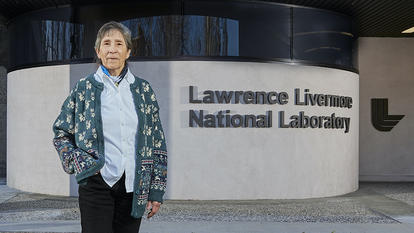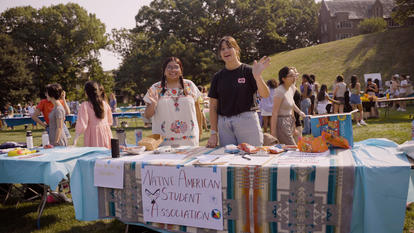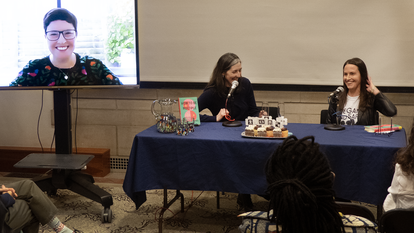What Wellesley Women Share

Students and alumnae often say that they chose Wellesley because they wanted to be part of a community not just for four years, but for a lifetime. That enduring bond is reflected in what Wellesley women share with each other, from memorabilia to life-changing support.
Some Wellesley-specific items are traditionally passed on, like hoops from seniors to first-years—i.e., “big sisters” to their “littles”—and tams from mother to daughter.
Laurel Wills ’17, a member of the Shakespeare Society, won this year’s hooprolling race (the tradition dates back to 1895) using a hoop that had been passed down within her Shakespeare Society sonnet family, Sonnet 55, since Amy Johannes ’01 created it her senior year. She will, in turn, give the hoop—which is inscribed with the line You live in this, and dwell in lover’s eyes—to the rising senior in Sonnet 55 for next year.
Occasionally Wellesley heirlooms come along that are so special that alumnae want to share them with fellow alumnae. Chrissy Purdie ’08, for example, was excited to let friends know that she had received 13 Wellesley Wedgewood plates from her grandmother Mary Lou Lawrence Purdie ’45, who had received them as a graduation present.
In some cases, alumnae start new pass-along traditions, as did Rachel Snyderman ’11, who purchased a Wellesley banner to use in her June 2014 wedding pictures. “The photos were amazing!” she said, but she wondered what to do with the banner after the big day.
Meanwhile, engagements and wedding photos of Wellesley classmates were popping up all over social media. Snyderman says she thought, “What if I could lend this to someone? And she could lend it to another? Etc., etc., etc.!”
Snyderman posted a wedding photo on Facebook and offered to lend the banner to other alumnae. “Within 10 minutes I had over 100 likes and 50 comments from brides asking for it. It was so much fun—and the ‘Sisterhood of the Traveling Banner’ was born!” she said.
Since then, the banner, which can be reserved via a Google document, has traveled to Wellesley weddings all over the East Coast and to Los Angeles. It may also go to Croatia and France in the coming year. “It certainly makes me feel connected to the alumnae community knowing that I could help contribute to another Wellesley wedding,” Snyderman said.
But what Wellesley women share most often is less tangible than a hoop or a banner: It is support and advice, said Susan Lohin, director of special operations in Alumnae Engagement, about everything from career moves to parenting to fashion. (She once saw a photo an alumna posted on a message board of a wedding dress she was considering buying. The consensus from the alumna’s friends: “Keep looking.”)
“I love the way alumnae constantly support one another to be bold and daring…the ‘just do it’ spirit’!” said Lohin.
Such encouragement meant a lot to CJ Frogozo ’02, who battled thyroid cancer in 2012. “When I was in the hospital, I received numerous messages via email and social media, as well as flowers and phone calls,” Frogozo said. “Jessica Tenaglia ’02 actually flew to Portland, Ore., where I was receiving radioactive iodine treatment, to ensure I felt taken care of. She even gave me a care package, which included a yoga mat, magazines, and some cozy socks…all of which I had to leave at the hospital because of radiation contamination.”
Frogozo, who is both a fitness instructor and the owner of a communications company, received tremendous support from alumnae friends this year as well, when their votes helped her beat 11 other finalists in an online competition for the title of America’s Most Inspiring Trainer.
“I can’t even describe what my Wellesley friends mean to me,” she said. “They have helped me through everything, whether it was battling cancer or getting a divorce or dealing with contract negotiations at work.”
Sometimes, alumnae even share the gift of life, as Liz Barbieri Hopkinson ’78 did in 2004 after reading in Wellesley magazine that Yolette Garcia ’77, her former dorm mate, needed a kidney in order to survive. Garcia, an Emmy-award winning journalist for radio and TV, had suffered for years from the effects of an underdeveloped kidney and had already tried the traditional routes to find a donor. Unfortunately, none of her friends, family members, or colleagues were a match.
Judy Colenback Savage ’79 suggested that Garcia explain her plight in the class notes. “I believed in my heart of hearts that her best hope for finding a living donor would be a willing Wellesley woman,” Savage told the magazine.
Hopkinson, who always reads the class notes, felt compelled to help, and Garcia was comfortable accepting the gift because “[Hopkinson] went to Wellesley. She is my sister. There is a peace and a comfort in that,” she said.



